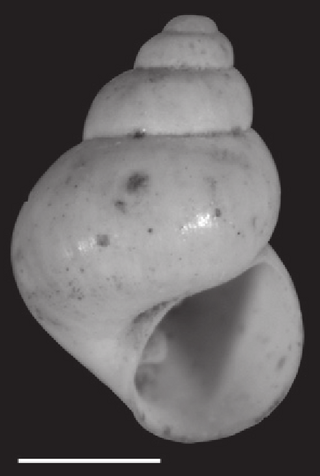
The female reproductive system is made up of the internal and external sex organs that function in the reproduction of new offspring. In humans, the female reproductive system is immature at birth and develops to maturity at puberty to be able to produce gametes, and to carry a fetus to full term. The internal sex organs are the vagina, uterus, fallopian tubes, and ovaries. The female reproductive tract includes the vagina, uterus, and fallopian tubes and is prone to infections. The vagina allows for sexual intercourse and childbirth, and is connected to the uterus at the cervix. The uterus or womb accommodates the embryo which develops into the fetus. The uterus also produces secretions which help the transit of sperm to the fallopian tubes, where sperm fertilize ova produced by the ovaries. The external sex organs are also known as the genitals and these are the organs of the vulva including the labia, clitoris, and vaginal opening.

Digenea is a class of trematodes in the Platyhelminthes phylum, consisting of parasitic flatworms with a syncytial tegument and, usually, two suckers, one ventral and one oral. Adults commonly live within the digestive tract, but occur throughout the organ systems of all classes of vertebrates. Once thought to be related to the Monogenea, it is now recognised that they are closest to the Aspidogastrea and that the Monogenea are more closely allied with the Cestoda. Around 6,000 species have been described to date.
The development of the urinary system begins during prenatal development, and relates to the development of the urogenital system – both the organs of the urinary system and the sex organs of the reproductive system. The development continues as a part of sexual differentiation.

The human reproductive system includes the male reproductive system which functions to produce and deposit sperm; and the female reproductive system which functions to produce egg cells, and to protect and nourish the fetus until birth. Humans have a high level of sexual differentiation. In addition to differences in nearly every reproductive organ, there are numerous differences in typical secondary sex characteristics.
The reproductive system of an organism, also known as the genital system, is the biological system made up of all the anatomical organs involved in sexual reproduction. Many non-living substances such as fluids, hormones, and pheromones are also important accessories to the reproductive system. Unlike most organ systems, the sexes of differentiated species often have significant differences. These differences allow for a combination of genetic material between two individuals, which allows for the possibility of greater genetic fitness of the offspring.

The reproductive system of gastropods varies greatly from one group to another within this very large and diverse taxonomic class of animals. Their reproductive strategies also vary greatly, see mating of gastropods.

Pseudunela cornuta is a species of minute sea slug, an acochlidian, a shell-less marine and temporarily brackish gastropod mollusk in the family Pseudunelidae. Adults are about 3 mm long and live in the spaces between sand grains.

Marstonia comalensis is a species of minute freshwater snail with a gill and an operculum, an aquatic gastropod mollusk or micromollusk in the family Hydrobiidae. It is found in south central Texas, United States.

Pseudorhabdosynochus americanus is a diplectanid monogenean parasitic on the gills of groupers. It was described as Diplectanum americanum by Price in 1937 and transferred to the genus Pseudorhabdosynochus by Kritsky and Beverley-Burton in 1986. The species was redescribed by Kritsky, Bakenhaster and Adams in 2015.

Pseudorhabdosynochus yucatanensis is a diplectanid monogenean parasitic on the gills of the red grouper, Epinephelus morio. It was described by Vidal-Martínez, Aguirre-Macedo & Mendoza-Franco in 1997 and redescribed by Kritsky, Bakenhaster and Adams in 2015.

Pseudorhabdosynochus justinella is a diplectanid monogenean parasitic on the gills of the red grouper, Epinephelus morio. It has been described by Kritsky, Bakenhaster and Adams in 2015.

Pseudorhabdosynochus kritskyi is a diplectanid monogenean parasitic on the gills of the gag, Mycteroperca microlepis. The species has been described by Dyer, Williams and Bunkley-Williams in 1995 and redescribed successively by Yang, Gibson and Zeng in 2005 and by Kritsky, Bakenhaster and Adams in 2015. The name of the species honours the American parasitologist Delane C. Kritsky.

Pseudorhabdosynochus sulamericanus is a diplectanid monogenean parasitic on the gills of the snowy grouper, Epinephelus niveatus, the Warsaw grouper, Epinephelus nigritus and the Haifa grouper, Epinephelus haifensis. It has been described by Santos, Buchmann & Gibson in 2000 , redescribed by Kritsky, Bakenhaster and Adams in 2015. and again redescribed by Chaabane, Justine, Gey, Bakenhaster & Neifar in 2016.
Microcotyle lichiae is a species of monogenean, parasitic on the gills of a marine fish. It belongs to the family Microcotylidae.
Microcotyle mouwoi is a species of monogenea, parasitic on the gills of a marine fish. It belongs to the family Microcotylidae.
Microcotyle stenotomi is a species of monogenean, parasitic on the gills of a marine fish. It belongs to the family Microcotylidae and was first described by Goto in 1899.
Microcotyle peprili is a species of monogenean, parasitic on the gills of a marine fish. It belongs to the family Microcotylidae.

Sibitrema is a genus which belongs to the phylum Platyhelminthes and class Monogenea; the only species included in this genus is parasite of fish.
Allobenedenia dischizosepta is a species of parasitic monogenean in the family Capsalidae. It has been found in waters off the coast of Argentina. It has been found infecting species of fish in the genus Acanthistius, such as the Argentine seabass.











